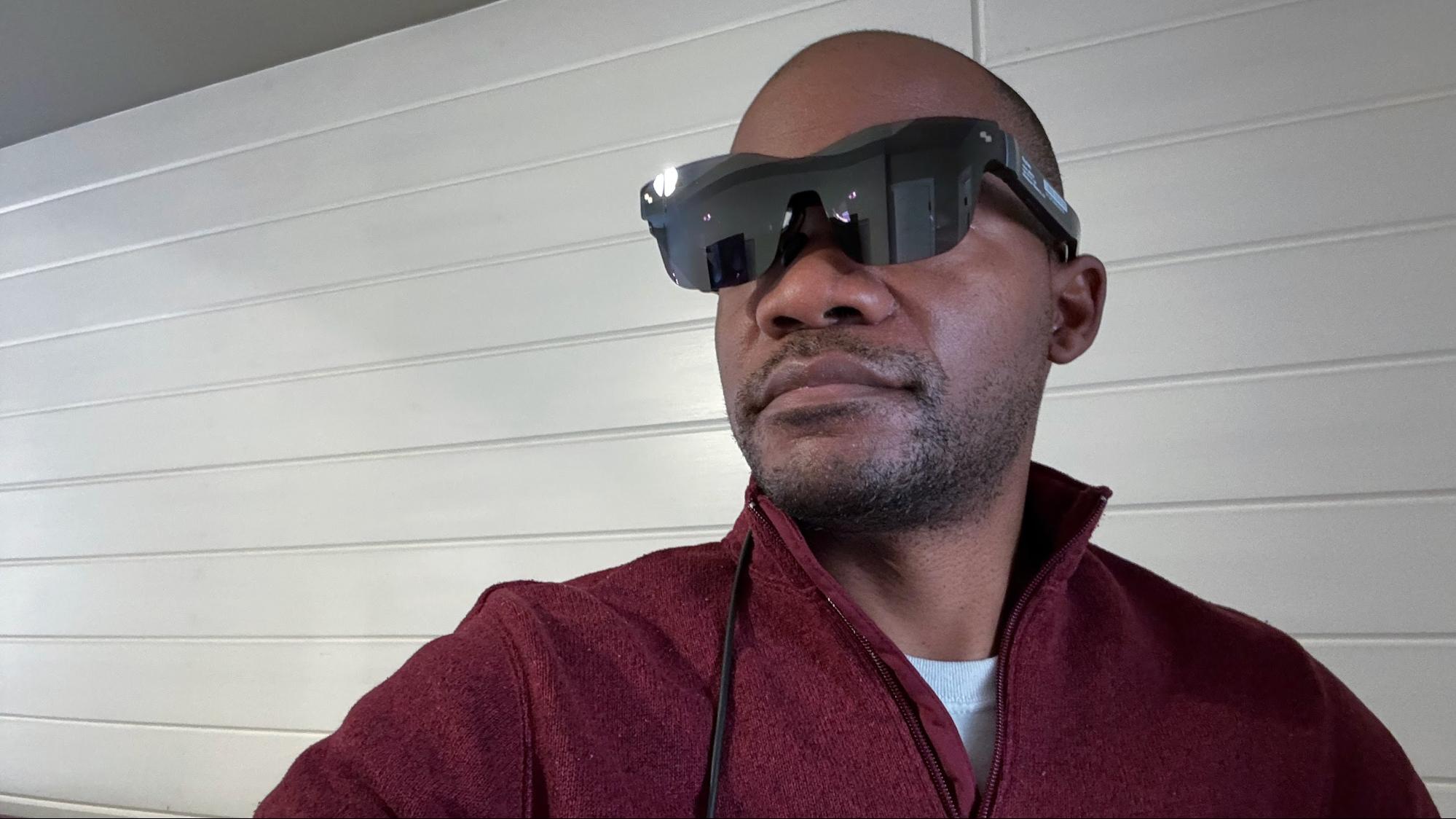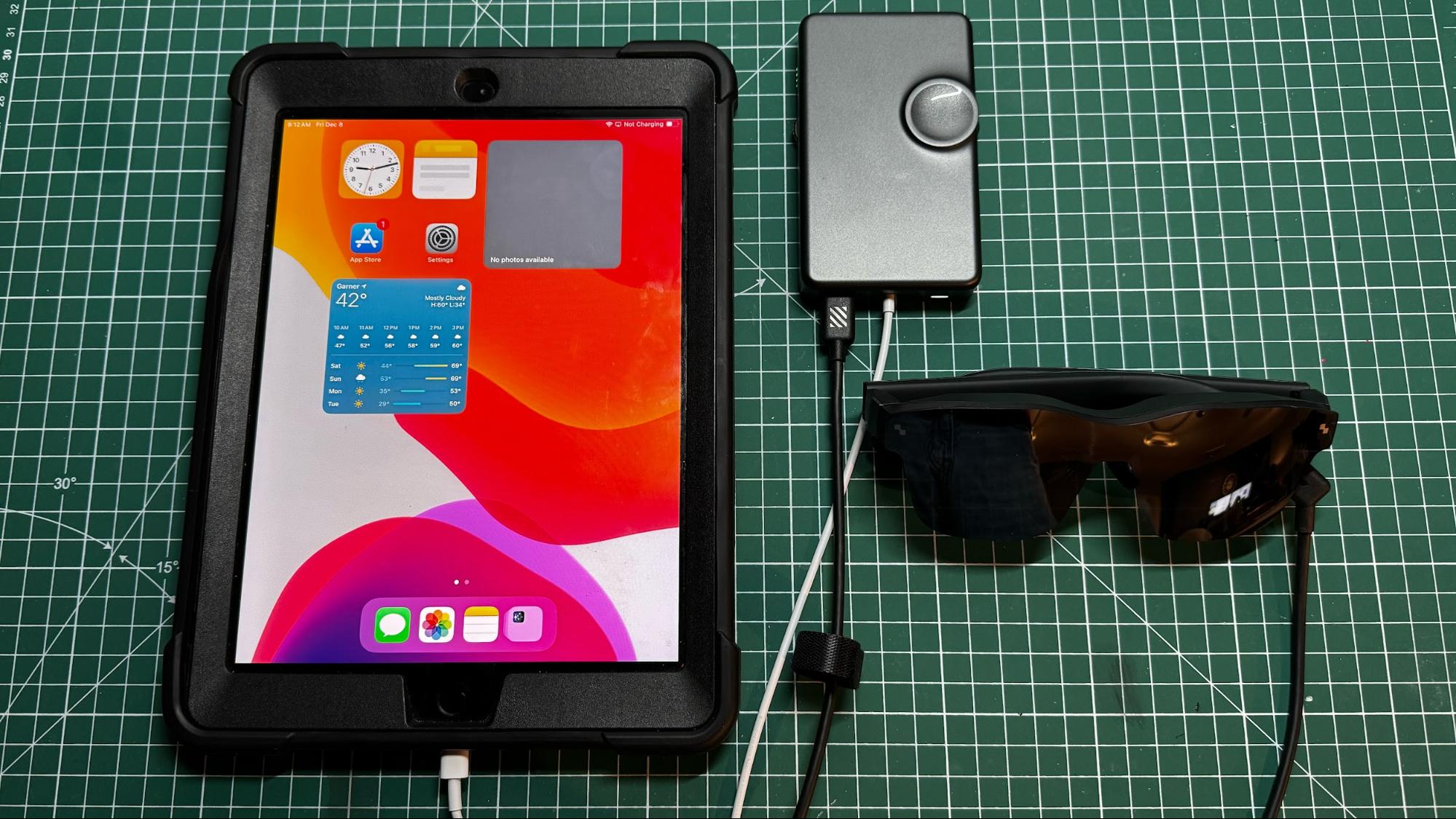Tom's Hardware Verdict
RayNeo has a solid foundation with the RayNeo Air 2, but a few simple changes could make an even better product.
Pros
- +
Bright Mini-OLED panels with good outdoor performance
- +
Sleek and lightweight design
- +
Wide compatibility with USB-C devices
Cons
- -
Horrible speakers
- -
Factory AR software is non-existent
- -
No hard case, light blocker or nose pad grips included in the box
Why you can trust Tom's Hardware
We're starting to see more players enter the augmented reality (AR) glasses field, with the most recent being the Xreal Air 2. Now, I have a new entry to look at with the RayNeo Air 2. It looks very similar to the Xreal Air 2 and even follows the same naming convention, but how does it compare in the real world to that device, which is one of our favorite AR headsets?
Design of the RayNeo Air 2
Much like the Xreal Air 2, the RayNeo Air 2 resembles a pair of beefy sunglasses. However, the RayNeo Air 2 has a sleeker, one-piece “frameless” design for the plastic lens. That lens is glued to the plastic frame, which houses all the essential components, including the dual Sony 120Hz Micro OLED displays.
The OLED displays are mounted high up in the frame and point downward onto the angled clear lens area, allowing you to see media content while still being able to see the world around you.
The left arm of the RayNeo Air 2 features a rocker switch for the volume, while the right arm has a rocker switch for adjusting the brightness of the Micro OLEDs. The right arm also has a USB-C port, which connects to your smartphone’s USB-C port. I should also note that both arms feature speakers, which RayNeo claims provide “Dynamic Stereo Sound” -- more on that later.

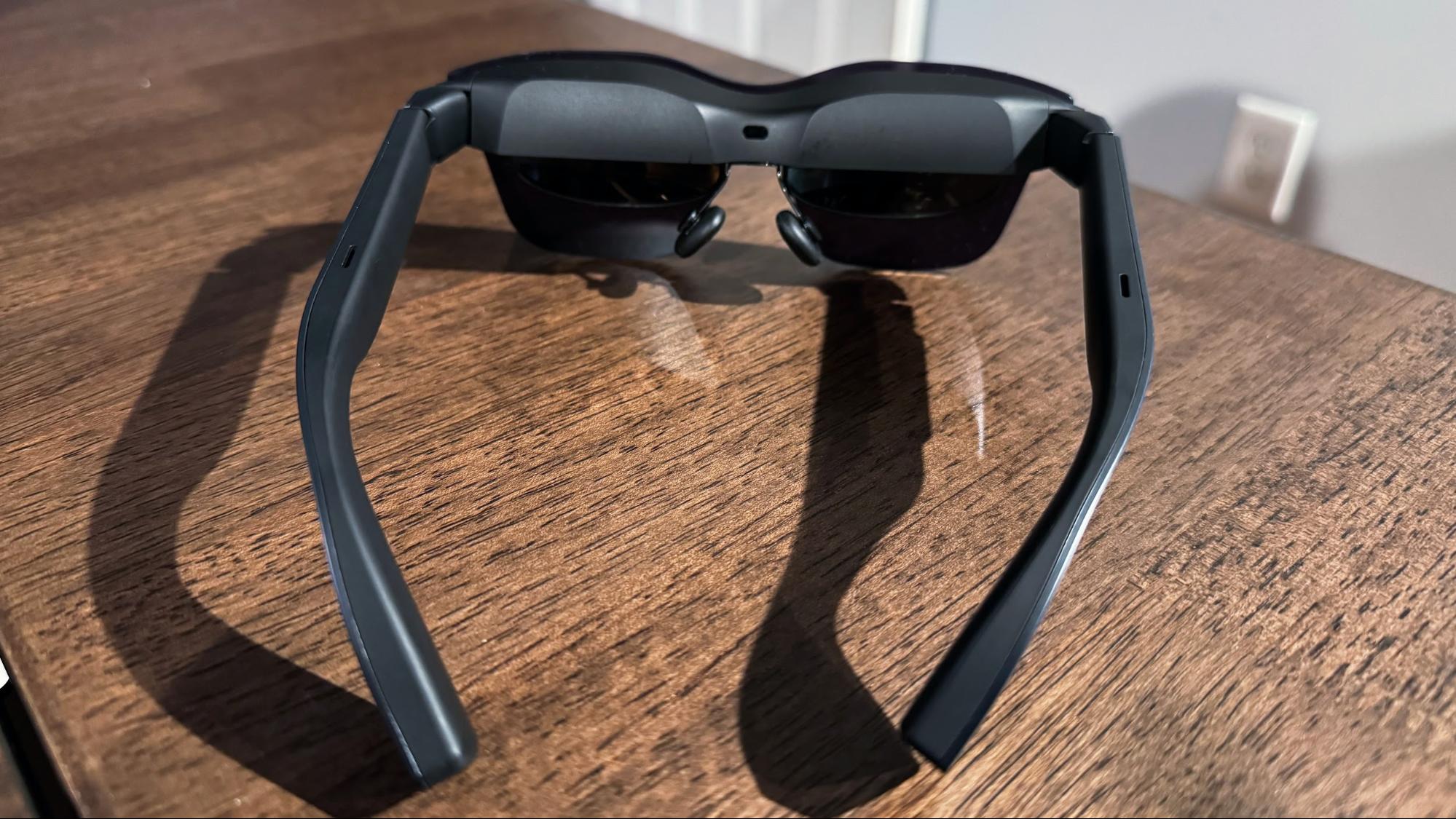
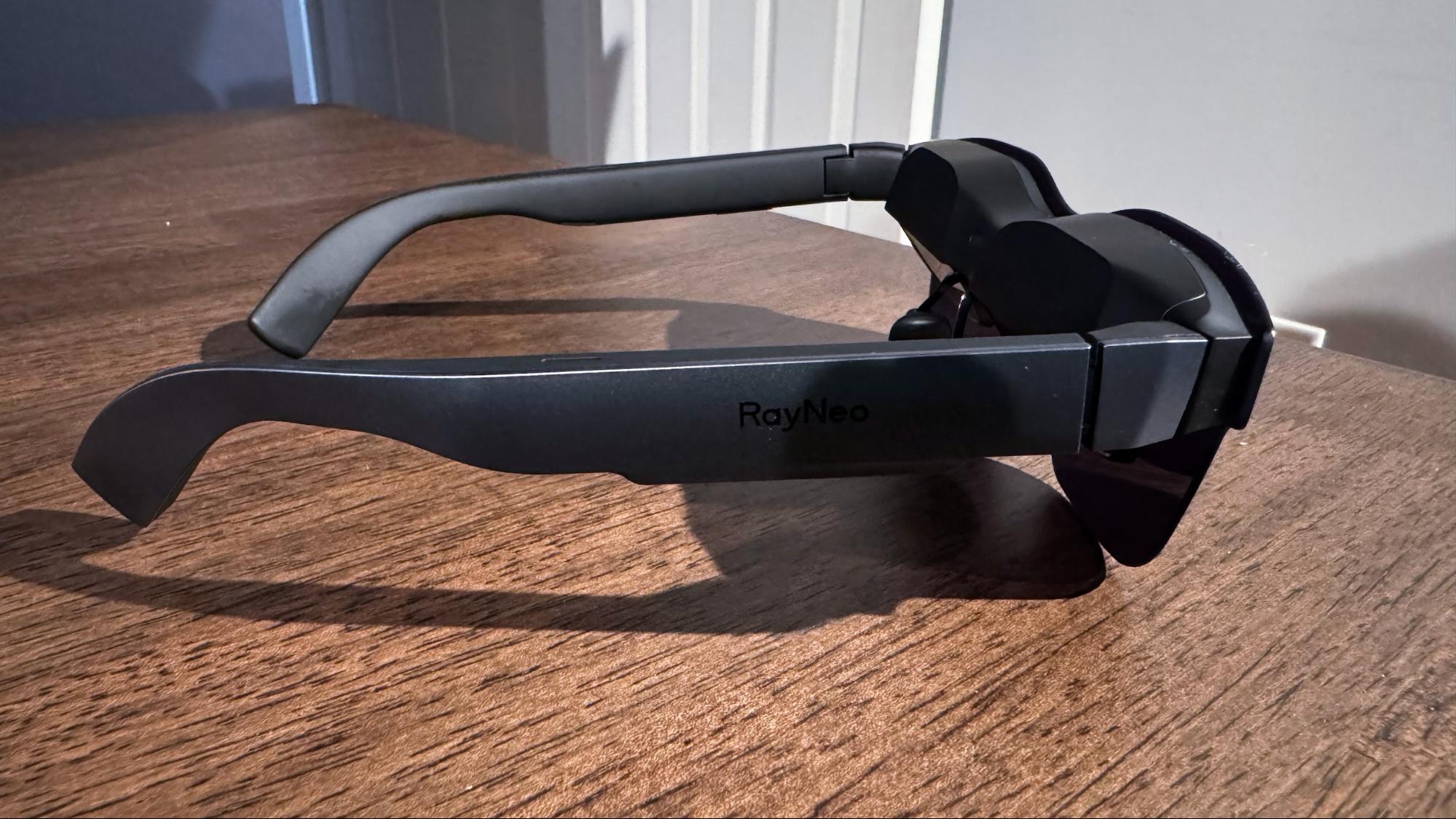
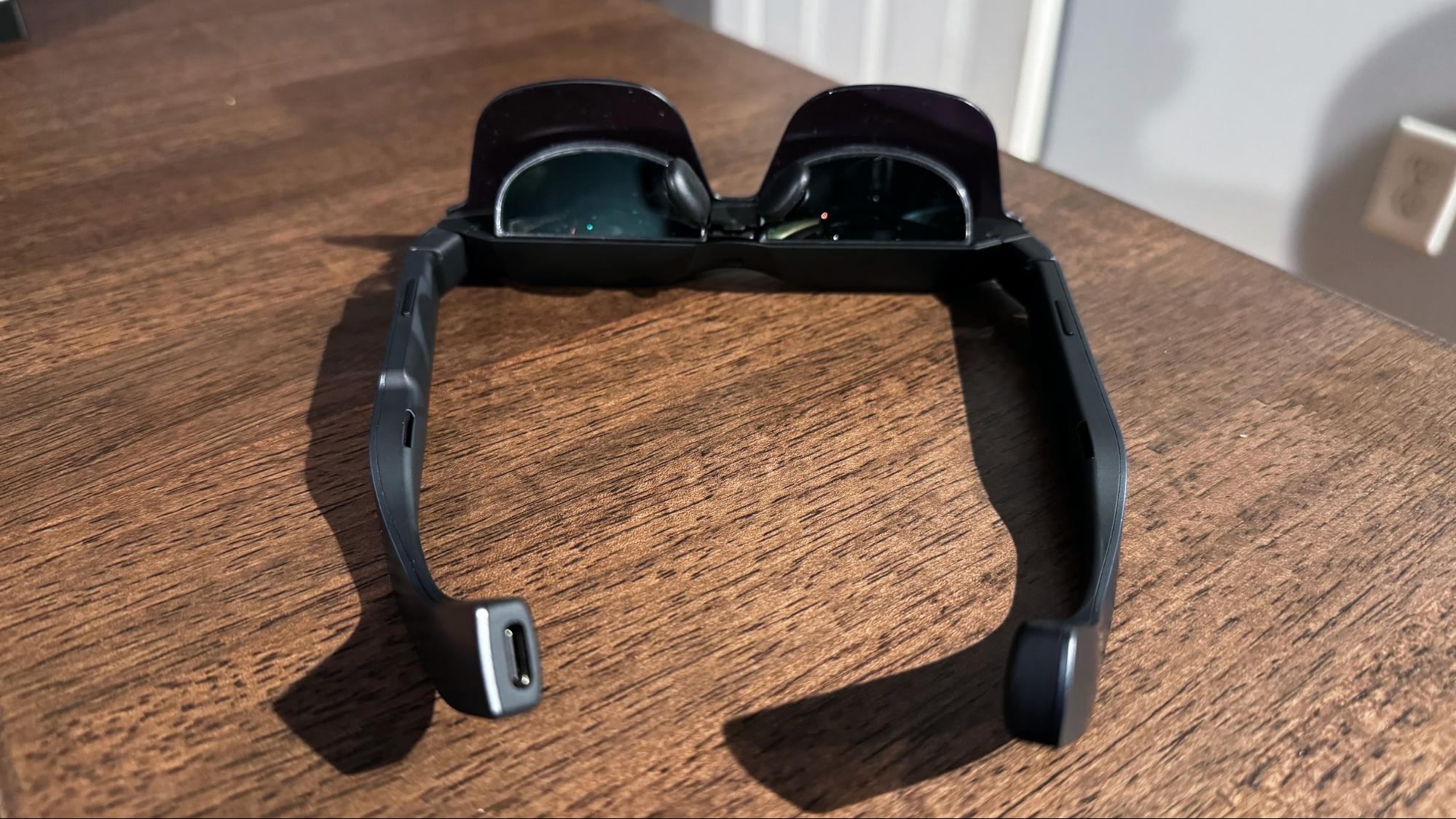

Unfortunately, there’s not enough adjustability. The Xreal Air 2 ships with four adjustable nose pad brackets to accommodate varying nose shapes and sizes. The RayNeo Air 2 ships with just one nose pad bracket. It is removable, so we assume that RayNeo will provide replacements (hopefully of different sizes) in the future. I had a hard time finding a comfortable fit with the default nose pad brackets, and had to slide the glasses further down on my nose to see the images output by the Micro OLEDs clearly.
RayNeo also doesn’t include a plastic light blocker with the Air 2, which can be used in brightly lit areas (which can cause the displayed image to fade). A small piece of plastic wouldn’t have added much to the cost of the glasses, so it’s another curious omission here.
Likewise, RayNeo only provides an oversized cloth bag to transport the Air 2 and its USB-C cable. On the other hand, the Xreal Air 2 ships with a hard case that protects the expensive hardware. This is even more concerning, given that there is no frame around the outer lenses, making them more susceptible to damage if dropped.
Get Tom's Hardware's best news and in-depth reviews, straight to your inbox.
However, a frame for prescription lenses and a cleaning cloth are included in the box.
The RayNeo Air 2 weighs 76 grams, slightly heavier than the Xreal Air 2 at 72 grams.
Specifications for the RayNeo Air 2
| Display | 1920 x 1080 per eye |
| Display Type | OLED |
| Brightness | 600 nits |
| Field of View | 46 degrees |
| Degrees of Freedom | 3 DoF |
| Audio | Dual open-air speakers |
| Connectivity | USB-C |
| Weight | 2.68 ounces (76 grams) |
Connecting the RayNeo Air 2
I tested the RayNeo Air 2 with a MacBook Pro, a Windows 11-based desktop, an iPhone 15 Pro Max and an iPad Pro. They all worked without issue. With the iPhone and iPad, I was asked to confirm the RayNeo Air 2 as a trusted device and had to enter my PIN. After that, the home screen was displayed on the glasses.
With the MacBook Pro and the Windows 11 desktop, I plugged the RayNeo Air 2 into a free USB-C port and the glasses showed up as a second monitor (extended desktop).
RayNeo Air 2 AR glasses with MiraScreen adapter and a Lightning port-equipped Apple iPad
Connecting to an iPhone or iPad with a Lightning port is a bit more complicated (and expensive). You’ll need to purchase a separate MiraScreen adapter. You plug the Lightning end of a cable into your iPhone/iPad and the USB-C end into the MiraScreen adapter. Then, you plug your Air 2 glasses into the adapter. It’s a bulky necessity to connect to an older device, but it at least includes a 4,500 mAh battery bank to keep you juiced up for longer.
Unlike Xreal, RayNeo doesn’t provide an adapter for wireless connectivity with a smartphone, tablet, or computer.
RayNeo Air 2 Hardware
The primary point of interaction with the RayNeo Air 2 is through the dual Sony-produced Mini OLED displays. Each display has a resolution of 1920 x 1080 and a refresh rate of up to 120 Hz. RayNeo says this arrangement is good enough to give you the impression that you’re viewing a 201-inch display.
RayNeo claims that the Mini OLED displays have a maximum brightness of up to 600 nits. That’s a 100-nit advantage over the Xreal Air 2, which was noticeable when wearing the glasses outside. The brighter display allowed me to see more of the displayed image and less of the background while outside.
However, my biggest issue with the RayNeo Air 2 is with the audio, which is subpar at best. The speakers were beyond horrible; at about mid-volume, the audio sounds muffled and distorted. There was also a hint of buzzing whenever music was playing, or people were talking in the media content I viewed.
It’s almost as if the various pieces of plastic making up the arms of the Air 2 were vibrating against each other, causing the grating distortion. The integrated speakers might work in a pinch, but I’d highly suggest using a pair of Bluetooth earbuds to avoid the disastrous audio system. I used Apple AirPods Pro and Beats Studio Buds without issue.
Using the RayNeo Air 2
The first challenge with the RayNeo Air 2 was finding the right fit for my face. As I mentioned earlier, RayNeo doesn’t include multiple nose pad brackets in the package, making it harder for users to get the perfect fit for their faces. I could bend the metal bracket slightly, allowing the glasses to sit a little lower on my face to get a clear picture. However, if the glasses move ever so slightly, the image goes from crystal clear to blurry.
As with the Xreal Air 2 I tested, I tried our various streaming apps with RayNeo Air 2, including Disney Plus, Amazon Prime Video, and Sling TV. I spent an hour watching “Indiana Jones and the Last Crusade” on Sling TV (commercials and all), and watched about half of a family favorite in the Hill household: Arnold Schwarzenegger’s “Jingle All the Way.” Even in my brightly-lit home office, the image quality was outstanding and sharp from edge to edge.
I walked around my house without issue with the glasses on while playing videos. It’s probably not recommended, as you can easily get distracted with the content playing, but I didn’t have an issue. Just be careful, as the outer lenses are dark-tinted, just like sunglasses, so your outward visibility diminishes inside.
Surprisingly, the RayNeo Air 2 proved to be usable outside in mid-day sunlight. While the screen would nearly wash out completely when I was gazing toward the sky, the resulting image was perfectly serviceable if an object was in the direct line of sight (a house, trees, a fence, etc.). Since RayNeo doesn’t include a plastic light blocker in the box, there’s no way to minimize the amount of light coming through when outdoors (unless you want to affix your own homemade solution).
Using the RayNeo Air 2 in macOS and Windows 11 was a mostly pleasant experience. Text was legible, and enough of my peripheral vision was intact to see my keyboard and mouse as I typed and navigated around each operating system’s user interface. I spent about an hour using the Air 2 in macOS and an hour in Windows 11 without any eyestrain or fatigue from wearing the glasses.
Although I wasn’t provided one to review alongside the Air 2, RayNeo will soon make a battery-powered Nintendo Switch Dock available (Late 2023). The RayNeo Air 2 glasses will plug into the dock, allowing you to game with the Nintendo Switch on a virtual 201-inch screen. However, there’s no word on how much that accessory will cost when it arrives.
Bottom Line
Augmented reality glasses like the RayNeo Air 2 and Xreal Air 2 are still in a weird space in the consumer tech area. They provide a low-impact way of enjoying content in a larger-than-life way (up to a virtualized 201-inch display) but don’t provide the same kind of total augmented reality and virtual reality immersion you get with something like the Meta Quest 3.
However, plopping on the couch, putting the glasses on after a long day, and engrossing myself in a movie was relaxing. I could also see the RayNeo Air 2 being a popular way to enjoy watching movies and TV shows on an airplane, where space is extremely limited. Putting on a pair of glasses like the RayNeo Air 2 provides a much better experience than watching “Die Hard” for the 77th time on a 14-inch laptop screen or, worse, on your smartphone’s relatively small display.
While I was impressed with the RayNeo Air 2’s overall image quality and its usability outdoors, I was taken aback by the stereo speakers. They are horrible, and I hope this is the first area that gets attention with the inevitable Air 3 successor. Also, RayNeo dropped the ball on the accessories in the box. A plastic light blocker should have been included, and a nice hard case should be mandatory to protect this pricey hardware. A cheap cloth bag doesn’t cut it for protection. Likewise, multiple nose pad brackets should be included, as they are with the competition.
At $379, the RayNeo Air 2 is only $20 cheaper than the Xreal Air 2. While it has slightly better outdoor viewing performance, it falls behind in audio quality and is slightly heavier. The Xreal Air 2 also supports wireless connectivity with the Beam adapter and more expansive augmented reality support through its Nebula software suite.
In the end, the RayNeo Air 2 is a good entry into the AR glasses market, but the Xreal Air 2 is a better thought-out product at the around $400 price point.

Brandon Hill is a senior editor at Tom's Hardware. He has written about PC and Mac tech since the late 1990s with bylines at AnandTech, DailyTech, and Hot Hardware. When he is not consuming copious amounts of tech news, he can be found enjoying the NC mountains or the beach with his wife and two sons.
